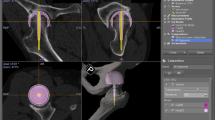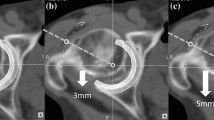Abstract
Purpose
This study investigates the accuracy of a computed tomography (CT)-based navigation system for accurate acetabular component placement during revision total hip arthroplasty (THA).
Methods
We performed a retrospective review of 30 hips in 26 patients who underwent cementless revision THA using a CT-based navigation system; the control group consisted of 25 hips in 25 patients who underwent cementless primary THA using the same system. We analysed the deviation of anteversion and inclination angles among the pre-operative plan, intra-operative records from the navigation system and data from postoperative CT scans.
Results
There were no significant differences between groups (P < 0.05) in terms of mean deviation between pre-operative planning and postoperative measurements or between intraoperative records and postoperative measurements.
Conclusion
CT-based navigation in revision THA is a useful tool that enables the surgeon to implant the acetabular component at the precise angle determined in pre-operative planning.


Similar content being viewed by others
References
Bourne RB, Hehin R (2004) The dislocating hip; what to do, what to do. J Arthroplasty 19(4 Suppl1):111–114
Choi HR, Anderson D, Foster S, Beal M, Lee JA, Barr C, Malchau H, McCarthy J, Kwon YM (2013) Acetabular cup positioning in revision total hip arthroplasty with Paprosky type III acetabular defects: Martell radiographic analysis. Int Orthop 37:1905–1910
Devane PA, Wraighte PJ, Ong DCG, Horne JG (2012) Do joint registeries report true rates of hip dislocation? Clin Orthop Relat Res 470:3003–3006
Garbuz DS, Masri BA, Duncan CP, Greidanus NV, Bohm ER, Petrak MJ, Della Valle CJ, Gross AE (2012) The Frank Stinchfield Award: dislocation in revision HA: do large heads (36 and 40 mm) result in reduced dislocation rates in a randomized clinical trial? Clin Orthop Relat Res 470:351–356
Hummel MT, Malkani AL, Yallanti MR, Baker DL (2009) Decreased dislocation after revision total hip arthroplasty using larger femoral head size and posterior capsular repair. J Arthroplasty 24(6 Suppl):73–76
Kajino Y, Kabata T, Maeda T, Iwai S, Kuroda K, Tsuchiya H (2012) Dose degree of the pelvic deformity affect the accuracy of computed tomography-based hip navigation? J Arthroplasty 27:1651–1657
Kalteis T, Handel M, Bäthis PL, Tingart M, Grifka J (2006) Imageless navigation for insertion of the acetabular component in total hip arthroplasty. J Bone Joint Surg Br 88:163–167
Kosashvili Y, Backstein D, Safir O, Lakstein D, Gross AE (2011) Dislocation and infection after revision total hip arthroplasty: comparison between the first and multiply revised total hip arthroplasty. J Arthroplasty 26(8):1170–1175
Kumar MA, Shetty MS, Kiran KG, Kini AR (2012) Validation of navigation assisted cup placement in total hip arthroplasty. Int Orthop 36:17–22
Kurts S, Ong K, Lau E, Mowat F, Halpern M (2007) Projections of primary and revision hip and knee arthroplasty in the United States from 2005 to 2030. J Bone Joint Surg Am 89:780–785
Labek G, Janda W, Agreiter M, Schuh R, Bohler N (2011) Organisation, data evaluation, interpretation and effect of arthroplasty register data on the outcome in terms of revision rate in total hip arthroplasty. Int Orthop 35:157–163
Lewinnek GE, Lewis JL, Tarr R, Compere CL, Zimmerman JR (1978) Dislocations after total hip-replacement arthroplasties. J Bone Joint Surg Am 60:217–220
Masonis JL, Bourne RB (2002) Surgical approach, abductor function, and total hip dislocation. Clin Orthop Relat Res 405:46–53
Miki H, Yamanashi W, Nishii T, Sato Y, Yoshikawa H, Sugano N (2007) Anatomic hip range of Moion after implantation during total hip arthroplasty as measured by a navigation system. J Arthroplasty 7:946–952
Murray DW (1993) The definition and measurement of acetabular orientation. J Bone Joint Surg Br 75:228–232
Nakamura N, Nishii T, Kitada M, Iwana D, Sugano N (2013) Application of computed tomography-based navigation for revision total hip arthroplasty. J Arthropasty Mar 21, in press
Pulido L, Rachala SR, Cabanela ME (2011) Cementless acetabular revision: past, present, and future. Revision total hip arthroplasty: the acetabular side using cementless implants. Int Orthop 35:289–298
Sanchez-Sotelo J, Berry DJ (2001) Epidemiology of instability after total hip replacement. Orthop Clin North Am 32:543–552
Soong M, Rubash HE, Macaulay W (2004) Dislocation after total hip arthroplasty. J Am Acad Orthop Surg 12:314–321
Splinger BD, Fehring TK, Griffin WL, Odum SM, Masonis JL (2009) Why total hip arthroplasty fails. Clin Orthop Relat Res 467:166–173
Sugano N, Nishii T, Miki H, Yoshikawa H, Sato Y, Tamura S (2007) Mid-term results of cementless total hip replacement using a ceramic-on-ceramic bearing with and without computer navigation. J Bone Joint Surg Br 89:455–460
Sugano N, Sasama T, Sato Y, Nakajima Y, Nishii T, Yonenobu K, Tamura S, Ochi T (2001) Accuracy evaluation of surface-based registration methods in a computer navigation system for hip surgery performed through a posterolateral approach. Comput Aided Surg 6(4):195–203
Sugano N, Takao M, Sakai T, Nishi T, Miki H (2012) Does CT-based navigation improve the long-term survival in ceramic-on-ceramic THA? Clin Orthop Relat Res 470:3054–3059
Sugano N, Takao M, Sakai T, Nishii T, Miki H, Nakamura N (2009) Comparison of mini-incision total hip arthroplasty through an anterior approach and a posterior approach using navigation. Orthop Clin North Am 40:365–370
Widmer KH, Zurfluh (2004) Complaint positioning of total hip components for optimal range of motion. J Orthop Res 22(4):815–821
Author information
Authors and Affiliations
Corresponding author
Rights and permissions
About this article
Cite this article
Kuroda, K., Kabata, T., Maeda, T. et al. The value of computed tomography based navigation in revision total hip arthroplasty. International Orthopaedics (SICOT) 38, 711–716 (2014). https://doi.org/10.1007/s00264-013-2166-0
Received:
Accepted:
Published:
Issue Date:
DOI: https://doi.org/10.1007/s00264-013-2166-0




